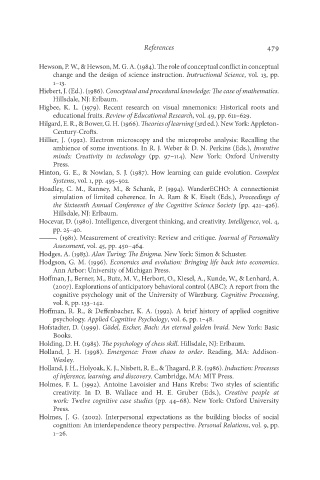Page 496 - Deep Learning
P. 496
References 479
Hewson, P. W., & Hewson, M. G. A. (1984). The role of conceptual conflict in conceptual
change and the design of science instruction. Instructional Science, vol. 13, pp.
1–13.
Hiebert, J. (Ed.). (1986). Conceptual and procedural knowledge: The case of mathematics.
Hillsdale, NJ: Erlbaum.
Higbee, K. L. (1979). Recent research on visual mnemonics: Historical roots and
educational fruits. Review of Educational Research, vol. 49, pp. 611–629.
Hilgard, E. R., & Bower, G. H. (1966). Theories of learning (3rd ed.). New York: Appleton-
Century-Crofts.
Hillier, J. (1992). Electron microscopy and the microprobe analysis: Recalling the
ambience of some inventions. In R. J. Weber & D. N. Perkins (Eds.), Inventive
minds: Creativity in technology (pp. 97–114). New York: Oxford University
Press.
Hinton, G. E., & Nowlan, S. J. (1987). How learning can guide evolution. Complex
Systems, vol. 1, pp. 495–502.
Hoadley, C. M., Ranney, M., & Schank, P. (1994). WanderECHO: A connectionist
simulation of limited coherence. In A. Ram & K. Eiselt (Eds.), Proceedings of
the Sixteenth Annual Conference of the Cognitive Science Society (pp. 421–426).
Hillsdale, NJ: Erlbaum.
Hocevar, D. (1980). Intelligence, divergent thinking, and creativity. Intelligence, vol. 4,
pp. 25–40.
———. (1981). Measurement of creativity: Review and critique. Journal of Personality
Assessment, vol. 45, pp. 450–464.
Hodges, A. (1983). Alan Turing: The Enigma. New York: Simon & Schuster.
Hodgson, G. M. (1996). Economics and evolution: Bringing life back into economics.
Ann Arbor: University of Michigan Press.
Hoffman, J., Berner, M., Butz, M. V., Herbort, O., Kiesel, A., Kunde, W., & Lenhard, A.
(2007). Explorations of anticipatory behavioral control (ABC): A report from the
cognitive psychology unit of the University of Würzburg. Cognitive Processing,
vol. 8, pp. 133–142.
Hoffman, R. R., & Deffenbacher, K. A. (1992). A brief history of applied cognitive
psychology. Applied Cognitive Psychology, vol. 6, pp. 1–48.
Hofstadter, D. (1999). Gödel, Escher, Bach: An eternal golden braid. New York: Basic
Books.
Holding, D. H. (1985). The psychology of chess skill. Hillsdale, NJ: Erlbaum.
Holland, J. H. (1998). Emergence: From chaos to order. Reading, MA: Addison-
Wesley.
Holland, J. H., Holyoak, K. J., Nisbett, R. E., & Thagard, P. R. (1986). Induction: Processes
of inference, learning, and discovery. Cambridge, MA: MIT Press.
Holmes, F. L. (1992). Antoine Lavoisier and Hans Krebs: Two styles of scientific
creativity. In D. B. Wallace and H. E. Gruber (Eds.), Creative people at
work: Twelve cognitive case studies (pp. 44–68). New York: Oxford University
Press.
Holmes, J. G. (2002). Interpersonal expectations as the building blocks of social
cognition: An interdependence theory perspective. Personal Relations, vol. 9, pp.
1–26.

